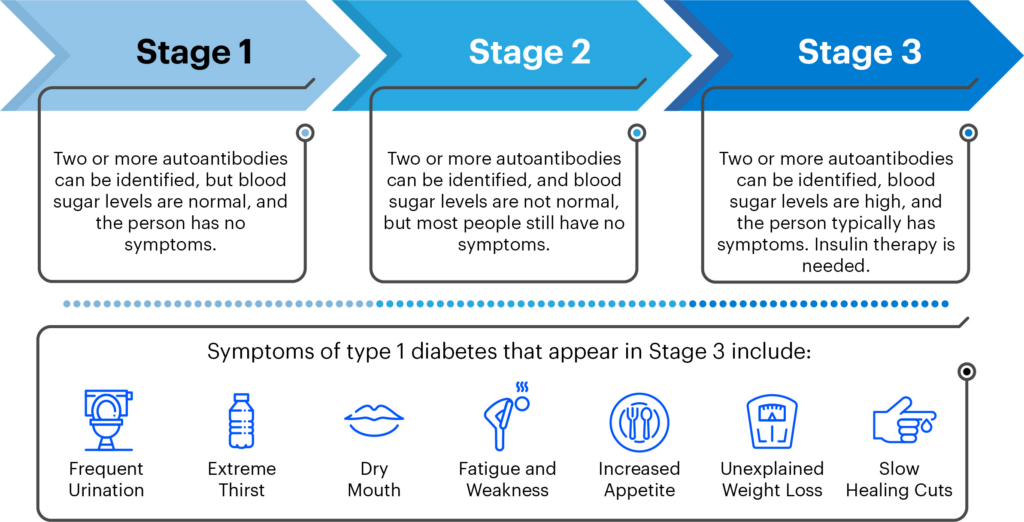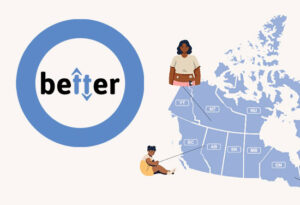
In collaboration with CIHR, JDRF Canada has recently announced a major funding opportunity in the area of screening for T1D risk. Here, we explain the reason why screening for T1D risk is central to our quest for cures.
Researchers use the word ‘cures’ deliberately, as there are many pathways to a world free from T1D. One such path is screening and prevention – catching the disease before the onset of clinical symptoms. T1D is an autoimmune disease, where the body attacks the beta cells in the pancreas responsible for producing insulin. The key to protecting beta cells is to discover this autoimmune response early enough to slow it down or halt it entirely.
Universal screening offers the potential to identify people who are at risk of developing T1D. Canada has one of the fastest growing rates of T1D diagnoses anywhere in the world – and we don’t know why. The more we screen people, the greater the likelihood of unlocking the mechanisms behind the development of the disease.
JDRF-funded research previously discovered that the presence of two or more specific markers indicative of an autoimmune response to the pancreas – called autoantibodies – indicates that a person is almost 100% likely to develop T1D in their lifetime. Screening also provides the opportunity to educate those at risk about the signs and symptoms of T1D and provide supportive follow-up, preventing the life-threatening complication diabetic ketoacidosis (DKA) at diagnosis. Finally, we know that while first-degree family members of T1D are at an elevated risk of developing T1D, around 85-90% of newly diagnosed cases do not have a direct family connection.
It’s not just about preventing DKA.
The prevailing medical wisdom used to be that T1D developed quickly, with a sudden onset of symptoms including thirst, hunger, increased urination, weight loss, and fatigue. Thanks to advances in screening and a better understanding of the human immune system, we now know that T1D does not develop suddenly but in fact the disease process usually starts long before insulin is required.
Once the immune system begins to attack the insulin-producing cells in the pancreas, we can detect markers in the blood (autoantibodies) that tell us a person is at increased risk. This is because the disease is otherwise asymptomatic or silent earlier on.
T1D happens in 3 stages:

Because most people do not have a family history of T1D, symptoms and a diagnosis often come out of the blue. In 25-45% of diagnoses in children in Canada, this unexpected diagnosis comes with DKA, a serious and life-threatening complication that can lead to death if not treated promptly. People with T1D know what to do to minimize the risk of DKA and to seek medical attention if it occurs—but people who have yet to be diagnosed do not. That’s why, unfortunately, a significant percentage of people experience DKA at diagnosis and require hospitalization.
To avoid this risk, everyone that wants to should have the opportunity to get tested for T1D autoantibodies. If a positive result is found, families could develop a plan for further monitoring with their doctor to avoid serious complications and lower the risk for life-threatening DKA at diagnosis. The hope is that in the future, there may be therapies that allow healthcare professionals to intervene and delay or even prevent T1D onset.
How to Get Screened
Currently, only family members of people with T1D can be screened for T1D risk through TrialNet. TrialNet is an international network of leaders in T1D research and clinical care with centers in the United States and internationally. A key goal of JDRF’s global research strategy is to support research that enables introduction of general population screening to identify high-risk individuals for early detection, reduce DKA at diagnosis, and accelerate the evaluation of disease-modifying therapies that could delay or prevent the disease.
What’s Next for Screening in Canada?
Now, JDRF Canada is pleased to announce a new funding opportunity in the area of T1D screening in partnership with the CIHR Institute of Nutrition, Metabolism and Diabetes. The goal of the CIHR-JDRF Type 1 Diabetes Screening Research Consortium is to develop a single nationally coordinated research network to explore key research questions about the feasibility and acceptability of a general population T1D screening program in Canada, building on experiences from other countries.
Most T1D screening studies have up to now focused only on family members. However, as 90% of people diagnosed with T1D do not have any family history, family-based screening does not identify most people at risk. This new funding opportunity looks to address this gap and help us better identify why T1D develops in Canadians, with potential benefits globally. As well, it will help advance research into potential disease-modifying therapies that could be applied at the moment high risk is identified in an individual.
Stopping T1D before it starts is the ultimate goal, and a universal screening program will be essential to prevent new diagnoses of this disease in the future.
We strongly encourage you to consult with your or your child’s physician for input as you make decisions about screening for T1D risk. Considering various sources of expert guidance and that from one’s own physician is the best way to make personal health choices.




